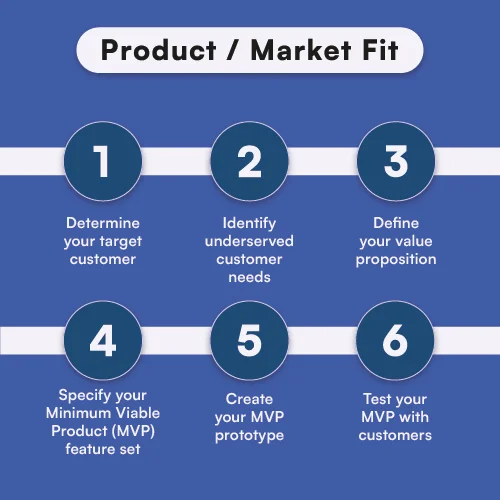Introduction
It is not important that your company always fits into the market; the market can make or break you if your product is subpar. Even the best product ideas can fail if there is no market for them, and a hungry market can starve if the proper innovative company ideas aren’t available.
A business that does not have the correct product for its market cannot be saved by investors or a marketing budget. Even the best advertisements and celebrity endorsements cannot compensate for the discrepancy.
Product market fit is both an art and a science. Sometimes the market will simply be interested in your large product idea. To target your ideal clientele, it may need to be tested, adjusted, or even recreated from the start.
What is Product-Market Fit?
The term “product-market fit” refers to the degree to which your product satisfies the needs of a viable market. A “Product-market fit” is achieved when a product has sufficient user traction to sustain steady expansion and is something that people want to buy.
A product’s long-term viability depends on its compatibility with the market. It’s comparable to something that’s completely unique and irreplaceable. Finding it or knowing when you have it isn’t always simple. Numerous industry professionals have discussed what makes a product successful in the marketplace.
Why is Product-Market Fit Important?
As a product manager, you’ll have to filter through a lot of information right away. Understanding the significance of identifying your product’s sweet spot in the market can feel like a hefty burden, but it’s critical. Finding the sweet spot between product viability and market demand can take time. The time spent on activities such as market research, planning, adjusting, and testing the market can quickly increase.
Strong product lines from well-established companies benefit immensely from a good product-market fit. It is critical to assess how well old and new items fit the market.
Finding the correct product-market fit is crucial for the growth of any organization, but especially for new businesses. It’s a circumstance in which they can either succeed or fail. It makes little difference how well a company’s product is manufactured if there is no demand for it.
The Product Market Benefits you in the Following Ways:
- Find the elements for your product that have to live up to customer demands or expectations.
- Who is most likely to be interested in your products, and why?
- How to catch the interest of potential clients and persuade them to buy a product?
- The things you need to do to encourage growth and win your satisfied consumers’ loyalty.
Examples of Product-Market Fit:
- Netflix
- Slack
- Uber
- Dropbox
- Airbnb
Who is Responsible for Product-Market Fit?
Marketing and product development teams are typically in charge of establishing the correct balance between product and market, but they are not the only ones involved. The organization as a whole must strive for PMF. Consider it a job that the sales and marketing teams, as well as customer service and finance, must all perform.
Most individuals believe that product-market fit is solely the responsibility of marketing and product management. But this is not the case. Instead, it is the responsibility of everyone who works on the product to ensure that it is marketable.
This evolves as a company grows. Entrepreneurs are constantly on the lookout for the best match between their products and the market. Most of it is also the responsibility of executive leadership in well-established organizations as part of developing the company’s overall strategy.
Ways to Determine a Product-Market Fit:
- One-to-One Customer Interviews
- Social Media Surveys
- Ad Campaigns
- Crowdfunding
- Reach out to your Customer Support Team
- AARRR Framework — Pirates Metrics
- The SaaS Rule of 40
Product-Market Fit Pyramid:

The above pyramid can help you figure out if your product is right for the market or not. There are five important parts of the pyramid, and each part of the pyramid is directly linked to the levels above and below it.
From bottom to top, the Product-Market Fit Pyramid includes five layers: your target customer, your customer’s unmet needs, your value offer, your feature set, and your user experience (UX).

Let’s learn the five layers of the pyramid in six easy steps:
-
Determine your Target Customer:
It all begins with your target audience, because they will determine whether your product fits their needs or not. Market segmentation should be used to determine who your ideal consumer is. Personas are an excellent approach to explaining your ideal consumer so that everyone on the product team understands who the product is intended for. You may not have a clear sense of who your target consumer is at first. That’s all right. You only need to begin with a broad concept and modify it as you learn more and attempt it again.
-
Identify Underserved Customer Needs:
Once you have a rough concept of who your target market is, the next step is to learn more about their wants and needs. As you work to provide customers with value, it’s important to identify the specific needs they have that coincide with a promising market opening.
-
Define your Value Proposition:
Your value proposition describes how you intend to address client needs better than the alternatives with your product. Which of the many conceivable desires that your product could fulfill for a buyer would you prioritize? You must determine what distinguishes your offering from those of your competitors. How will your product outperform the competition? What unique features of your product will make customers happy? This is the essence of product planning.
-
Specify your Minimum Viable Product (MVP) Feature Set:
When you’ve determined your value proposition, you must specify the features of your minimum viable product. You don’t want to work too hard and spend too much time on a product only to find out later that the public dislikes it. The MVP approach’s purpose is to construct only what is required to provide your target consumer with enough value to demonstrate that you are on the right track. Customers may inform you that your MVP lacks a feature that is critical to them. Alternatively, they may inform you that they will not use a feature you included in your MVP. The idea is to make minor improvements until you have an MVP that customers consider adequate.
-
Create your MVP Prototype:
To put your MVP hypotheses to the test with buyers, show them a version of your product so they may provide feedback. User experience (UX) design will be required to bring your feature set to life for your clients. Prototypes can differ in terms of realism (how closely they resemble the final product) and engagement (how much the user can interact with the prototype in comparison to how much they can with the final product). A hand-drawn image of your product on paper or a chalkboard would be low-resolution and ineffective. For online and mobile apps, wireframes with medium detail and mockups with high detail are frequently utilized.
-
Test your MVP with Customers:
Once your MVP prototype is ready, it’s time to have people try it out. In this step, it’s important to make sure that the people you ask for feedback from are in your target market. If you don’t, you might get customer feedback that sends you in the wrong direction as you try to improve. This goal can be reached with the help of a “screener,” which is a short survey to make sure that study participants have the same traits as your ideal customer.
This pyramid shows how important it is to find the target market and unmet customer needs before making a product. Thus, before you start making the product, you should look at the Product-Market Fit Pyramid and make sure you understand each level.
How to Measure Product-Market Fit?
Without a clear measurement process even, the fanciest concept is useless. Measuring product/market fit is quite challenging, but it is also the key to ensure that your product has succeeded. The goals you’ve set during the early stage are used to track the product’s engagement metrics.
PMF is Measured by the Below Mentioned Steps:
-
Understand the Current Needs of Your Customer and Foresee Their Future Needs:
Understanding consumer needs requires time and practice. You can’t succeed without knowing your target customer. Thus, you can visit customers, study the market, attend business trade events, etc. This lets you create relationships and learn what the industry requires. Understanding your clients’ concerns will help you connect with them and create trust over time.
-
Keep Your Focus on the Value Proposition:
Finding the most important thing is challenging but crucial. To locate the important features, look at how things are evolving and where your competitors are having problems finding answers. Customers will gladly wait for new features if your solution solves a major issue.
-
Build Your Credibility:
Customers always want to know how your product or service will help them, and the easiest way to show them is to tell a story about your brand that includes their needs.
-
Measure TAM:
Tracking your development is essential. Calculate the total addressable market (TAM). TAM is calculated by dividing the total number of potential consumers in a market by your average revenue per user.
-
Send Surveys:
Polls must follow TAM determination. Sending surveys to your target market is the greatest approach to see if your product is right for them and what they think of your services. These polls ask customers if they value your product and would miss it if it disappeared.
Product-Market Fit Myths:
- Achieving PMF often happens “Spontaneously”
- It is evident when you achieve the product-market fit
- Once you have achieved the PMF, then you can’t lose it
- Having product-market fit gives you an advantage over your competitions
- Having PMF that means your business has the potential to dominate its market
Product-Market Fit as a Marketing Solution:
Are you confident that PMF can help you build your business and is the greatest technique for a company to sell itself?
There are certain exceptions, but in general, it is beneficial to your company to seek Product-Market Fit.
You must trust in the process to provide it with the tools it requires to reach PMF. It is critical for the growth of your firm, regardless of how long it takes, to determine what is true and what is untrue about the market. So, the most crucial thing you need to keep running and making money is your consumers. Customers are the most crucial thing you can invest in to learn about their preferences.
Want to improve product quality and customer retention. Using Cuneiform’s product-market fit services could increase product awareness, tempt new customers, and inspire existing ones to act on decisions. You can be certain of assistance and support for your products thanks to the advanced assistance of PMF, boosting both quality and sales.




